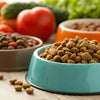What to Add to Kibble to Make Your Dog Eat
- Houndsy
Table of Contents
- Introduction
- The Importance of Variety in Your Dog's Diet
- Top Additions to Enhance Kibble
- Tips for Successfully Enhancing Kibble
- Conclusion
Introduction
Did you know that over 60% of dog owners in the United States primarily feed their pets kibble? While dry dog food is incredibly popular due to its convenience and affordability, many dogs can become bored with the same flavors and textures day after day. If your dog has recently turned up its nose at the kibble in the bowl, you're not alone. Many pet parents face this dilemma, leading us to wonder, "What can we add to kibble to make our dogs eat?"
By enhancing their kibble with nutritious and tantalizing additions, we can not only entice our furry friends to eat but also improve their overall diet. In this blog post, we will explore a variety of ingredients that can be mixed into your dog’s kibble to make it more appealing. We’ll also touch on the benefits of each addition and provide tips for implementing these changes into your dog’s feeding routine.
By the end of this article, you'll have a comprehensive understanding of how to elevate your dog's mealtime experience—making it something they eagerly anticipate rather than a chore. So, let’s dive into the world of kibble enhancements and discover how we can make mealtime exciting once again!
The Importance of Variety in Your Dog's Diet
Understanding Kibble
Kibble is a common choice among dog owners because it offers a balanced diet and is easy to store and serve. However, it is often highly processed, which can lead to a lack of variety in your dog’s diet. Just like us, dogs can get bored with their meals. A monotonous diet not only affects their appetite but may also lead to nutritional deficiencies. To combat this, we can add various foods to their kibble to enhance taste, texture, and nutrition.
Nutritional Needs of Dogs
Dogs require a balanced diet that includes proteins, fats, carbohydrates, vitamins, and minerals. While many high-quality kibbles are formulated to meet these needs, adding fresh foods can provide additional nutrients and make meals more enjoyable. Incorporating fresh ingredients into your dog's diet can also support their immune system, improve digestion, and promote overall health.
Exploring Dog Preferences
Every dog is unique, and their taste preferences can vary widely. Some dogs may prefer softer textures, while others enjoy crunchy bites. By exploring various additions to their kibble, we can cater to our dog's individual tastes, making mealtime an enjoyable experience. What better way to bond with our furry companions than through delicious food?
Top Additions to Enhance Kibble
Now, let’s explore some of the best additions to improve your dog’s kibble experience. We will include a mix of proteins, vegetables, grains, and flavorful toppings that not only entice your dog to eat but also provide nutritional benefits.
1. Eggs: The Protein Powerhouse
Eggs are a fantastic source of protein and essential fatty acids. They are also rich in vitamins and minerals that contribute to your dog’s overall health. You can serve eggs scrambled, boiled, or raw—just ensure they are fresh and clean.
Benefits:
- High in protein for muscle health.
- Contains omega-3 fatty acids for a shiny coat.
- Easy to digest.
How to Add: Start with half an egg for smaller dogs and a whole egg for larger breeds. Mix it with their kibble for a tasty meal.
2. Cooked Lean Meats
Adding cooked chicken, turkey, or lean beef is an excellent way to increase protein in your dog's diet. These meats provide essential amino acids that support muscle development and overall health.
Benefits:
- High protein content for energy and strength.
- Rich in vitamins like B6 and B12.
How to Add: Chop cooked meat into small pieces and mix it into the kibble. Avoid seasoning, as some spices can be harmful to dogs.
3. Canned Pumpkin: The Digestive Hero
Canned pumpkin (not the spiced pie mix) is an excellent addition due to its high fiber content. It aids digestion and can help regulate your dog’s bowel movements.
Benefits:
- High in fiber to prevent constipation.
- Contains vitamins A and C for immune support.
How to Add: Mix in one to two tablespoons of canned pumpkin with your dog's kibble based on their size.
4. Greek Yogurt: The Creamy Indulgence
Plain, unsweetened Greek yogurt is rich in probiotics, which can help improve your dog’s gut health. It also adds a creamy texture that many dogs love.
Benefits:
- Supports digestive health.
- Provides calcium and protein.
How to Add: Mix one tablespoon of yogurt with their kibble for a tasty topper.
5. Fresh Fruits
Many dogs enjoy fruits like apples, bananas, and blueberries. These fruits can provide vitamins, antioxidants, and fiber.
Benefits:
- Offers vitamins and antioxidants.
- Low in calories for a healthy treat.
How to Add: Cut fruits into small, bite-sized pieces and mix them into the kibble. Always remove seeds and pits.
6. Vegetables
Adding cooked vegetables like carrots, green beans, or sweet potatoes can increase the nutritional value of your dog's meal. These vegetables are rich in vitamins and minerals.
Benefits:
- High in fiber for digestive health.
- Low in calories, making them a healthy addition.
How to Add: Steam or cook vegetables until soft, then chop and mix them with the kibble.
7. Bone Broth: The Flavor Booster
Bone broth is a flavorful addition that can make kibble more appealing. It’s rich in nutrients and can provide hydration, especially for dogs who may not drink enough water.
Benefits:
- Provides hydration and flavor.
- Contains collagen for joint health.
How to Add: Pour warm bone broth over the kibble and let it soak for a few minutes before serving.
8. Fish: The Omega-3 Fatty Acid Source
Fish, such as salmon or sardines (in water), are great sources of omega-3 fatty acids, which are beneficial for your dog’s skin and coat.
Benefits:
- Supports skin and coat health.
- Provides essential fatty acids for brain health.
How to Add: Mix in a small portion of canned fish or cooked fish into their kibble.
9. Peanut Butter: The Tasty Treat
Many dogs love peanut butter! It’s a great source of protein and healthy fats. Just ensure it’s free from xylitol, which is toxic to dogs.
Benefits:
- Provides healthy fats and protein.
- Aids in weight management when used in moderation.
How to Add: Spread a thin layer of peanut butter over the kibble or mix it in.
10. Cottage Cheese: The Calcium-Rich Addition
Cottage cheese is another dairy option that can be beneficial for dogs. It’s high in protein and calcium, but should be offered in moderation to avoid digestive upset.
Benefits:
- Provides protein and calcium.
- Aids in muscle recovery.
How to Add: Mix a small spoonful of cottage cheese with the kibble.
Tips for Successfully Enhancing Kibble
While adding ingredients to your dog's kibble can be beneficial, there are some key points to consider to ensure a smooth transition:
- Introduce Gradually: When adding new ingredients, introduce them slowly to avoid digestive upset. Start with small amounts and monitor your dog’s reaction.
- Quality Matters: Always choose high-quality, fresh ingredients free from additives or preservatives to ensure your dog’s health.
- Balance is Key: Remember that kibble should still form the majority of your dog’s diet. Aim for a balanced approach, where 90% of their intake comes from kibble, and the remaining 10% from the added ingredients.
- Consult Your Vet: If you have concerns about your dog’s diet or health, consult your veterinarian for personalized advice.
Conclusion
By exploring the various options available for enhancing your dog's kibble, we can make mealtime a joyful experience for our furry friends. From protein-packed eggs and lean meats to nutrient-rich vegetables and fruits, the combinations are endless. Not only can these additions make kibble more appealing, but they also contribute to a balanced diet that supports your dog's health and well-being.
As pet owners, it’s our responsibility to provide our dogs with the nutrition they need while making their meals enjoyable. So, why not try mixing in some of these tasty additions to see which ones your dog loves the most? Remember, mealtime should be a delightful experience for both you and your furry companion.
If you're looking for a beautiful and functional way to serve your dog’s kibble, consider the Houndsy Kibble Dispenser. It combines innovative design with perfect portion control, making feeding time easy and enjoyable.
FAQ
1. Can I add too many toppings to my dog’s kibble? Yes, it's important to ensure that added ingredients do not exceed 10% of your dog’s daily caloric intake to maintain a balanced diet.
2. What if my dog has specific dietary restrictions? Consult your veterinarian before introducing new foods, especially if your dog has allergies or health concerns.
3. Are all fruits and vegetables safe for dogs? No, some fruits and vegetables can be toxic to dogs (like grapes and onions). Always research or consult with a vet before introducing new foods.
4. How can I tell if my dog is allergic to a new food? Watch for signs of allergies such as itching, gastrointestinal upset, or unusual behavior, and discontinue the new food if you notice these symptoms.
5. What is the best way to introduce new foods? Start with small amounts and gradually increase as your dog adjusts, ensuring you monitor for any adverse reactions.
By integrating these delicious and nutritious additions to your dog’s kibble, we can create a delightful dining experience that keeps our pets happy and healthy!












